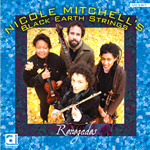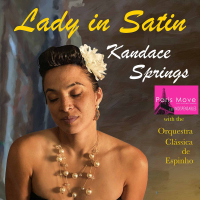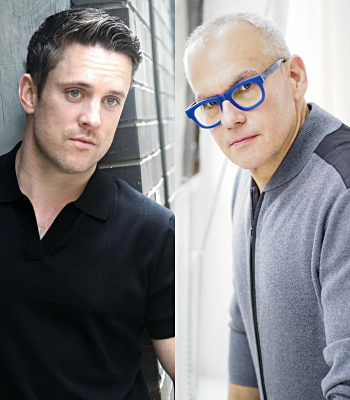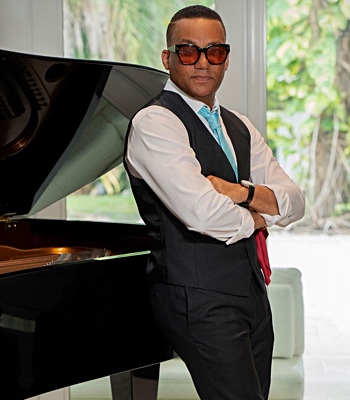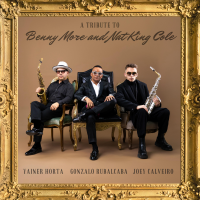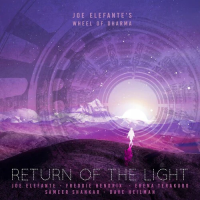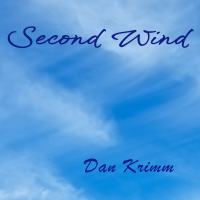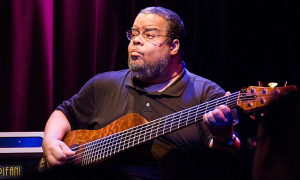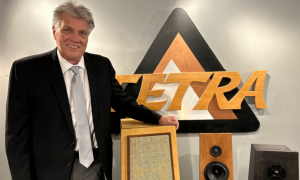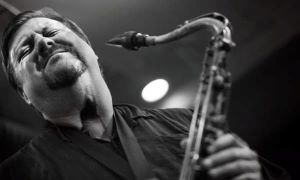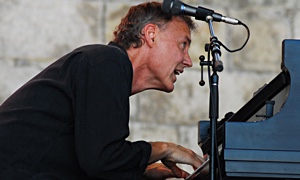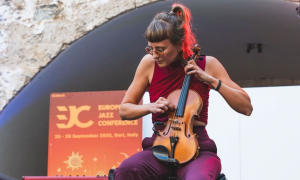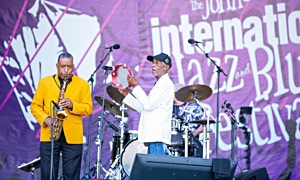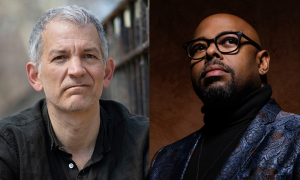Home » Jazz Articles » Live From New York » July 2009
July 2009
Smoke
New York City June 4, 2009
When the Smoke Big Band, under the direction of Bill Mobley, crowded onto the Smoke bandstand for its second set (Jun. 4th), the focus was on music by '80s-era Jazz Messengers alumni: Billy Pierce, Donald Brown and Mulgrew Miller. Mobley is a trumpeter, but in this setting he solely conducted, leaving the playing to a crack 15-piece band. They began with Pierce's "Sudan Blue," swinging at mid-tempo with pinpoint stabs and lush chordal beds from the horns. Tenorist Jason Rigby played the leadoff solo and Tim Sessions gave the trombone response, capped by Jason Brown's drum breaks. Next came Donald Brown's blistering "New York," with fiery solo blasts from trumpeter Andy Gravish, tenor saxophonist Danny Walsh and pianist Jon Davis. Miller's "Second Thoughts" scaled the tempo back a bit, though Jon Gordon's alto, Dylan Canterbury's trumpet and Davis' piano kept the heat high. Mobley then unveiled his arrangement of a Phineas Newborn obscurity, "Requiem for Bud," full of shimmering dissonance and an absorbing quasi-stride piano interlude. "49th Street," Mobley's tricky line on "Lover" changes, voiced with flutes and muted trumpets, was a strong finale, showcasing Jim Rotondi's flugelhorn, Andy Gutauskas' baritone sax and a three-way trombone battle featuring Sessions, John Yao and Noah Bless. A consummate pro, Mobley tapped into a very live current in jazz history, keeping his gang tight while encouraging a sense of risk.
Jane Ira Bloom
Tea Lounge
Brooklyn, NY
June 5, 2009
Unfolding throughout June at Brooklyn's Tea Lounge, the Bloom Festival was conceived by its curators, Tanya Kalmanovitch and Lara Pellegrinelli, as a double homage: to the season of rebirth and to soprano sax innovator Jane Ira Bloom, who headlined the festival's second night (Jun. 5th) in a trio with bassist Mark Helias and drummer Bobby Previte. Bloom is fond of playing not just tunes, but mélanges, improvised epics. And so her first set flowed from the quick, swing-based "Jackson Pollock" to the funky "Unconscious Forces" to the dark ballad "Climb Inside Her Eyes". Much like trumpeter Bill Dixon, Bloom uses two microphones treated with electronic effects to modify her horn—not with echo, but rather a harmonizer that splits her runs into parallel intervals, generating otherworldly surprises. Her rapid physical swoops of the horn, from mic to mic or in wide circles and horizontal lines, also make for a richer sonic experience than the average jazz show. Given this, Bloom's addition of keyboardist Rob Ray for the second medley—"Live Sports" into "Vanishing Hat" into "Electro-Chemistry"—seemed unnecessary. Ray's sampled voices and washes of synthesized electro-noise called to mind DJ Olive's work with Uri Caine. But there was a feeling of disorganization, not least of all when one of Ray's three keyboards began shrieking horribly and had to be shut off. The trio had a compelling enough rapport to carry the whole show. Why mess with it?
—David R. Adler
Jacob Garchik
I-Beam
Brooklyn, NY
June 6, 2009
Trombonist Jacob Garchik's trio is a book not to be judged by its cover. The leader's compositions are quizzically satisfying. "Medium," for example, is complex and knotty, with tightly scored changes. The gently loping "Waltz" is graceful but hardly metered. And, at least on Jun. 6th, when they appeared at I-Beam, "Duo" was played by all three members. The trio (with Jacob Sacks on piano and Dan Weiss on drums) has been playing together for several years and it showed in the ways they approached Garchik's smart compositions, which often felt strangely tempo-less but were never quite still. The changes were sometimes sudden, although in familiar hands never felt abrupt. All three played quite beautifully, somewhere between together and apart, but just as there weren't overt themes there was rarely lead or support. And while the pieces hardly seemed imbued with momentum, they were still filled with lots of little rhythms; Sacks and Weiss were meticulously relentless in creating fractals around the shifting themes. Together the group managed to strike a similar balance to the Alex von Schlippenbach trio, structuring the spontaneity of European free improvisation into compositions that flow from the genuinely serene to a disjointed swing. The close confines of I-Beam, a studio on the industrial side of Park Slope in Brooklyn about big enough for 20 chairs and a baby grand, seem to demand close attention, something that befitted what the trio had to present.
Humanization 4tet
Downtown Music Gallery
New York, NY
June 8, 2009
The Portuguese guitarist Luis Lopes has tricks up his sleeve. As evidenced on his new Clean Feed CD What is When, he is an adept player of noise and feedback (as opposed to simply a maker, Lopes is the rare guitarist who can use it quite tastefully). But such is not the stuff of his Humanization 4tet. On their self-titled CD from last year and appearing at Downtown Music Gallery on Jun. 8th (the last stop on an America tour that took them along the Eastern Seaboard and down to the rhythm section's Texan homeland), Lopes takes a cleaner, more melodic approach. The group seems to play Lopes' compositions inside-out, beginning in a freer vein, moving slowly until Lopes or saxophonist Rodrigo Amado (or sometimes both players in tandem) rise slowly, unexpectedly, to state a theme. The restraint shown on the melody instruments is also surprising given the powerful backline (bassist Aaron and drummer Stefan Gonzalez, sons and regular bandmates of incendiary trumpeter Dennis Gonzalez). Amado is fully capable of gritty tenor playing and Lopes' battery of effect pedals gave him the foundation to break free of the bright, clean tone of his hollowbody, but their measured approach was subtly rewarding. It wasn't until two final group improvisations, during which Daniel Carter joined them on trumpet and alto saxophone, that they traipsed rockier terrain, Lopes pushing his axe in more directions. But even his string scrapings proved to be thoughtful and musical.
—Kurt Gottschalk
Miles Okazaki
Jazz Gallery
New York, NY
June 12, 2009
Composer/guitarist/illustrator Miles Okazaki brought his group to Jazz Gallery on Jun. 12th-13th to premiere Generations, his second album as a leader. Saturday's early set reenacted the album in its entirety, performed live just as it was recorded: in order, in one continuous take. The first-rate band included alto saxophonists Miguel Zenon, Christof Knoche and David Binney, vocalist Jen Shyu, bassist Hans Glawischnig (covering for Jon Flaugher) and drummer Dan Weiss. Beginning with the accelerating pulses of "Overture," answered a full hour later by the slowly decelerating "Moon," Okazaki's music continually engaged the audience's perceptions of time and tonality by chain-linking remotely related chords in quick succession and superimposing beat groupings and accent patterns to create compound shapes and phrases. In spite of this density, the music evolved organically, inevitably, helped in large part by fine soloing all around. Okazaki, playing at a low volume with a light touch, was subtle yet assertive, his comping tastefully apropos. Zenón was relentlessly intense, sounding both lyrical and aggressive on "Waves" and "Generations". Shyu's voice added warmth to the blend, easily matching the horns over the tricky, unpredictable compositions. Binney, Knoche and Glawischnig all had fine moments as well, but the MVP award properly belongs to Weiss, whose irrepressible beat and mercurial creativity provided both the spark and the glue.
Abdullah Ibrahim
Jazz Standard
New York, NU
June 10, 2009
South African pianist Abdullah Ibrahim, the artist-formerly-known-as-Dollar Brand, was at Jazz Standard for a week-long residency—three nights solo followed by three with his group Ekaya. Wednesday's (Jun. 10th) early set was subdued and intimate, a non-stop, stream-of-conscious musical meditation that, like Duke Ellington's suites, coursed through a series of impressionistic vignettes, each with its own color scheme, gently flowing from one hue to the next. With no band behind him, Ibrahim was free to follow the dictates of his imagination, drawing on songs and musical textures he has played over the years, ideas that by now have become second nature. His style, encompassing Cape Town grooves, gospel hymns, Ellington-Strayhorn compositions, the melodic contours of swing and bop, as well the angularity of Thelonious Monk, is nevertheless uniquely his own, shaded with delicate dissonances and, at its core, infused with a folksy earthiness and directness of delivery that is never overshadowed by intellectual complexity. Ibrahim's rhythms, relaxed in the manner of swing, hewed closer to the lilt of township jive than to jazz; his improvisations, typically anchored to a mode or key area, gently resisted tonality with subtle chromaticism or stark melodic leaps. Approaching target tones from below, he often delayed their resolution for dramatic effect. As the spell of the music deepened, Ibrahim rocked back and forth on his stool, an enchanter enchanted.
—Tom Greenland
Oliver Lake
Sweet Rhythm
New York City
June 5, 2009
One of the most soulful voices to emerge out of the '70s avant-garde, Oliver Lake evinces a musical vision that is both expansive and inclusive, drawing freely from myriad traditions to create a consistently forward-looking body of work that stands out for its inventiveness and originality. Leading his Organ Quartet at Sweet Rhythm (Jun. 5th) the iconoclastic altoist propelled the popular '50s "soul jazz" format into the future with a sound that was raucous and relaxing at the same time. Lake's frontline partner trumpeter Freddie Hendrix, whose experiences range from Rufus Reid's quintet to the J.B.'s Reunion Band, proved to be the perfect foil for the leader, their strong individual tones melding in dissonant harmony to create a walloping whole with a powerful punch even stronger than the sum of its four-fisted parts. Jared Gold's central role in the group contributed greatly to its distinctive sound, drawing judiciously from the Hammond organ's popular vocabulary but avoiding the trite clichés that forced the instrument out of favor. Drummer Bill McClellan provided the freewheeling rhythmic force that helped drive Lake and Hendrix' extroverted conversations into new territory in a program of original compositions by the leader. The opening "Backup" had a storytelling quality that emphasized the voicelike attributes of Lake's horn that remained evident throughout the set, which ended with a stirring reading of the gospel classic "I Want to Walk with Jesus".
Warren Smith
Minton's Playhouse
New York, NY
June 13, 2009
Multi-instrumentalist Warren Smith demonstrated his much-heralded versatility from the very outset of his first set at Minton's (Jun. 13th), sitting behind the legendary club's drum kit to kick off the evening, drafting a young pianist from the audience to join him and bassist Leon Dorsey while waiting for the rest of his band to arrive from an earlier engagement. The trio jammed on a couple of standards prior to Smith's calling up another drummer from the audience so that he could take his place at the vibraphone to swing a version of Milt Jackson's "Bags Groove," the evening's one piece in the spirit of its billing as a Tribute to the MJQ. The appearance of drummer Eli Fountain (himself a flexible vibraphonist-percussionist in the Smith tradition) and pianist Alva Nelson moved the band into a more energized mode with a pulsating reading of "Afro Blue" that began with the former's chanted introduction and was marked by the latter's powerful percussive Tyner-ish chords. Smith's lyrical modality on the vibes here demonstrated his admitted affection for the style of Bobby Hutcherson, although on "In A Sentimental Mood" and "Sonnymoon For Two" the influence of Jackson was equally evident. The addition of the Last Poets' Don Eaton on djembe added to the contemporary flavor of the second set which included lively versions of War's "The World Is A Ghetto" and Stevie Wonder's "Overjoyed," proving that there's still plenty of swinging jazz to be mined from the pop and R&B music catalogues.
—Russ Musto
Recommended New Listening:
* Kevin Hays Trio—You've Got a Friend (Jazz Eyes)
* Ron Horton—It's a Gadget World (ABEAT)
* Tony Malaby—Paloma Recio (New World)
* Tim Posgate Hornband—Banjo Hockey (Black Hen)
* Alan Sondheim & Myk Freedman—Julu Twine (Porter)
* EJ Strickland—In This Day (Strick Muzik)
—David Adler NY@Night Columnist, AllAboutJazz.com
* John Hébert—Byzantine Monkey (Firehouse 12)
* Steve Lehman Octet—Travail, Transformation, and Flow (Pi)
* Nicole Mitchell's Black Earth Strings—Renegade (Delmark)
* Roberto Rodriguez—Timba Talmud (Tzadik)
* Swiss Improvisers Orchestra—Zwitzerland (Creative Sources)
* The Thing—Bag It! (Smalltown Superjazzz)
—Laurence Donohue-Greene Managing Editor, AllAboutJazz-New York
* Paul Dunmall/Matthew Bourne/Dave Kane/Steve Davis—Moment to Moment (SLAM)
* Avram Fefer—Ritual (Clean Feed)
* Peter Kowald/Vinny Golia—Mythology (Kadima Collective)
* Torben Snekkestad—Conic Folded (ILK Music)
* Jonas Struck/Kasper Tranberg/Anders Christensen/Kresten Osgood—Thunderstrucks (Blackout)
* Yom—New King of Klezmer Clarinet (Buda Musique)
—Andrey Henkin Editorial Director, AllAboutJazz-New York
Tags
PREVIOUS / NEXT
Support All About Jazz
 All About Jazz has been a pillar of jazz since 1995, championing it as an art form and, more importantly, supporting the musicians who make it. Our enduring commitment has made "AAJ" one of the most culturally important websites of its kind, read by hundreds of thousands of fans, musicians and industry figures every month.
All About Jazz has been a pillar of jazz since 1995, championing it as an art form and, more importantly, supporting the musicians who make it. Our enduring commitment has made "AAJ" one of the most culturally important websites of its kind, read by hundreds of thousands of fans, musicians and industry figures every month.



